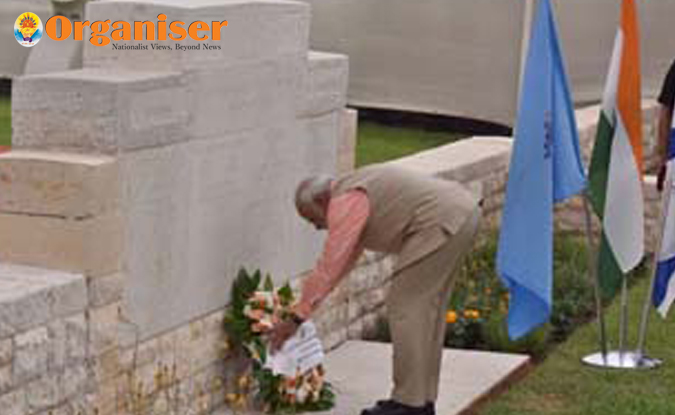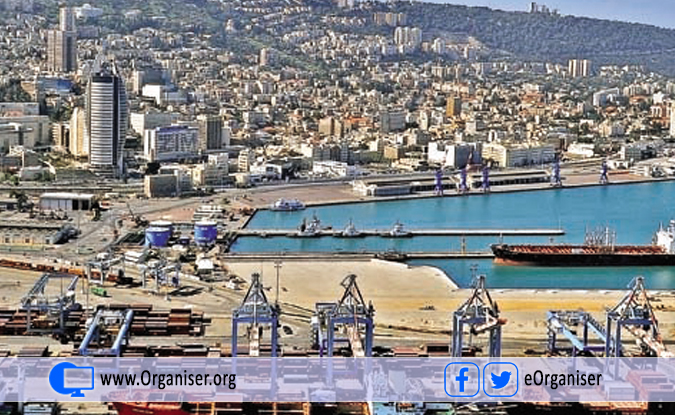In 1933, the new port of Haifa, the first modern port in Palestine, was opened. It is said whoever controls Haifa, controls Israel. Haifa’s history from its origin is an inseparable part of Israel’s history
Seshadri Chari
The history of modern State of Israel starts with the supreme sacrifice of 900 brave Indian soldiers who died liberating the Port of Haifa from the Ottoman rule on September 23, 1918 during World War-I. The port city was under Palestinian administration then. The graves of Indian soldiers are looked after by the Government of Israel till this day. Their names, bravery and sacrifice are included in history text books in Israel.

Haifa History
On the eve of World War I, Haifa, with more than 20,000 inhabitants and a constantly expanding export-import trade, was the key city of northern Eretz Israel. A progressive European minority added to its cosmopolitan character and an extensive network of schools provided a high standard of education.
British Mandate Period
On September 23, 1918, after four centuries of Ottoman rule, Haifa was captured in fierce battles by the British forces. During the British Mandate, Haifa rapidly grew into a large modern city in which the Jewish population played an increasingly predominant role. In 1919 the Haifa-Lydda railroad was added to the narrow gauge Haifa-ema-Dara line. In the 1920s and 1930s the road network which linked up the various parts of Haifa was greatly improved and extended.
The graves of Indian soldiers in Haifa are still looked after by the Government of Israel. Their names, bravery and sacrifice taught in text books of Israel
The 1922 census recorded a population of 25,000 in Haifa, of whom more than 9,000 were Muslims, slightly fewer Christian Arabs, and more than 6,000 Jews. According to the 1931 census, it contained 50,403 residents, including about 20,000 Muslims, 15,923 Jews, and about 14,000 Christians. By 1944 the number of inhabitants had grown to 128,000 of whom 66,000 were Jewish, 35,940 Muslim, 26,570 Christian, and 3,000 Bahais. At the end of the Mandate (1948) the Jews comprised nearly two-thirds of the population (about 100,000 out of 150,000).
On October 31, 1933, the new port of Haifa, the first modern port in Palestine, was opened. The Mandatory government chose this site because of its natural harbor and its proximity to important shipping lanes, to rail transport to the rest of Palestine and Egypt, and to the Hejaz railway to Jordan and Syria. Haifa was also the administrative centre of the north. The completion of the large harbor in 1934 produced a great burst of prosperity and Haifa became the main and practically only port of international repute in Eretz Israel, taking precedence over Jaffa.

Haifa’s economy was further strengthened by the completion in 1939 of the oil pipeline from Iraq to its Mediterranean terminus at Haifa and the large oil refineries near the city. At this time the port facilities encouraged many new industries, some of them the largest in the country (textiles, glass, bricks, petroleum products, cement, metal, ceramics, etc.), in Haifa and the vicinity, especially in the Zebulun Valley. Tension between the city’s Arab and Jewish residents, in the Mandate period, however, impeded Haifa’s development. The riots of 1936–39 in particular adversely affected the city’s economy and business dwindled between the conflicting sides as well as trade with Syria and Lebanon. The Arab population, mainly concentrated in the lower city, obstructed the Jews on their way to the adjoining industrial areas and to the port and services adjacent to it (marine shipping companies, banks, transport, insurance, etc.), as more and more Jews from the 1920s onward settled in the Hadar ha-Carmel section (the continuation of the Herzliyyah district founded before World War I). Hadar ha-Carmel developed rapidly around the Technion, which was inaugurated in 1925. The Mandate authorities granted some municipal autonomy to the new Jewish quarter.
The Jewish settlement in this period also climbed higher up the slope around Merkaz ha-Carmel, in the Auzzat Herbert Samuel quarter, and in Neveh Sha’anan. When the land in the Zebulun Valley on the coast of the bay was purchased in 1928, the Zionist movement made its first venture into comprehensive urban planning, for which it engaged the British city planner Patrick Abercrombie. The area stretching from the southeast corner of the bay up to Acre was divided into functional regions – an industrial zone in the south near the port; a residential area in the center in which from 1930 onward the Kerayot were built (Kiryat Hayyim, Kiryat Bialik, Kiryat Motzkin, Kiryat Yam); and an agricultural belt in the north.
Toward the end of the British Mandate, both the Jews and the Arabs attempted to gain control over the city. The hostilities which broke out at the end of 1947 reached a peak on April 21–22, 1948, when the British suddenly decided to evacuate the city. In a lightning military action, the Haganah captured the Arab quarters and took over the city. Only about 3,000 of Haifa’s 50,000 Arab residents chose to remain in the city; the rest, in response to the Arab High Command’s orders, refused to accept Jewish rule and abandoned their homes. But contrary to the Arabs, the Bahai sect, with its world centre in Haifa, built a gold-domed sanctuary and cultivated one of the finest and largest gardens in the country. In 1987 the Bahais begin to enlarge the gardens, added 18 hanging gardens running for a kilometer along the slopes of the mountain and thus linking the upper part of the mountain with the lower part. In addition, the Bahais built other buildings, among them a library and administrative building. Another unique feature of the city is the Carmelit, Israel’s only subway which was set up in 1959.
In the State of Israel
Late in 1948 Haifa’s population numbered 97,544, of whom 96% were Jews. At the end of 1950 there were 140,000 inhabitants; at the end of 1952, 150,600; at the end of 1955, 158,700; in 1961, 183,021; and at the end of 1967, 209,900. In the mid-1990s, the population was approximately 246,500, including 35,000 new immigrants. At the end of 2002 the population of was Haifa 270,800, making it the third largest city in Israel after Jerusalem and Tel Aviv. Of Haifa’s non-Jewish population, 10 per cent are Arabs, 60 per cent of them Christian and 30 per cent Muslim.
In the 1950s and 1960s a number of changes were made in the functional arrangement of the city with Haifa and Acre being conceived as the axes of a comprehensive regional scheme. In the Haifa Bay area the industrial zone extended north along the coastal dune strip up to Acre and included “Steel City.” Residential quarters were built east of this zone. On Mt. Carmel the crest and narrow spurs branching off to the West and East were reserved for building and parks and orchards fill the gorges. Downtown Haifa extended Westward, spilling over Southward into the Carmel Coast area. After the establishment of the State of Israel, the port was greatly expanded and modernsed and became the home port of Israel’s fast-growing navy. The piers were tripled in number, the water level deepened, and many port facilities added, such as the Dagon storage silos with a 75,000 ton capacity. In 1954 an auxiliary port was built at the Kishon River outlet, its pier was lengthened in 1964 to 2,099 ft. (640 m.). A shipyard for building and repairing ships, a floating dock, and a jetty for Israel’s fishing fleet were also built in the Kishon area (1959). Haifa continued to be almost the exclusive embarkation and debarkation sea point in Israel. It is said that whoever controls Haifa, controls Israel. Haifa’s history from its origin is an inseparable part of Israel’s history
(The writer is former editor of Organiser and now heads WH Network)














Comments